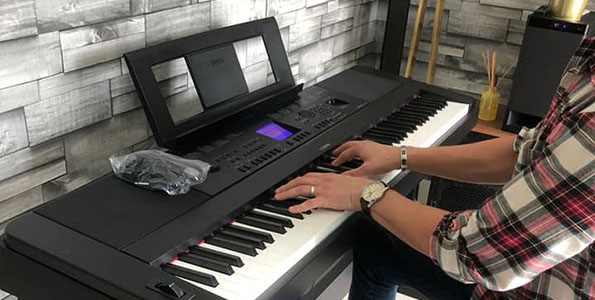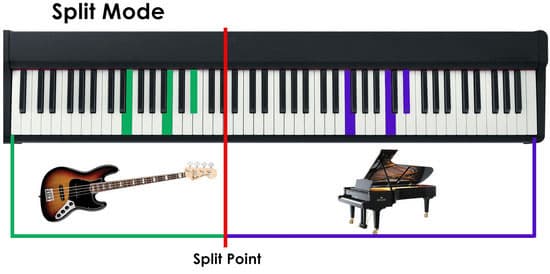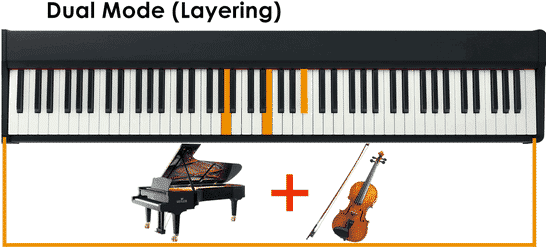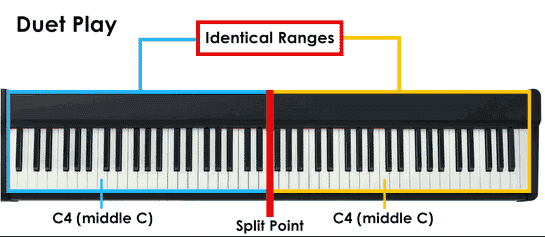No matter what you do, having well-tuned equipment will enhance your experience, whether to learn or polish a skill.
The same goes for the piano, and Yamaha might be the right choice for you.
The brand offers tons of options, including Yamaha DGX-660 vs P125, the two intermediate-level instruments we're going through shortly.
Which one is better? What're the differences between Yamaha P125 vs DGX-660? What to look for when you purchase them? Follow us through this review and choose the one that suits you!
Yamaha DGX-660 vs P125 - The Similarities Features
Regardless of coming from different lines, Yamaha P125 vs DGX-660 are quite similar in core features. This is, to us, a surprise when we look deeper into these two models.
Design
They all have white and black versions of themselves. The two models feature matching stands which are pretty sturdy and can handle weight confidently.
Sound
Regardless of coming from different lines, both P125 vs DGX-660 host the same Pure CF sound engine.
This engine uses samples of the world's acclaimed Yamaha CFIIIS 9' Concert Grand.
Not to mention, the P125 and DGX 660 are equipped with 192-note polyphony, which means you're able to layer more sounds and use backing tracks without worrying.
In case you have no idea what is polyphony, it represents the number of notes that a digital piano can produce simultaneously.
If you like layering sound or record multi-tracks, it is desirable to have at least 64-note polyphony.

Speakers
The built-in speakers of them are decent enough to use. Especially, these models utilize the IAC – Intelligent Acoustic Control function.
What it does is that IAC automatically adjusts bass and treble frequencies to achieve better balance and make notes more audible at a lower volume.
Keyboard
The Yamaha DGX 660 and P125 are 88-key fully weighted keyboards. Not to mention, they use the same Hammer Action GHS system to mimic the acoustic piano feel.
GHS reproduces the heavier low-end key and progressively lighter toward high keys. This is extremely helpful, especially if you're switching to an acoustic piano in the future.
While it's becoming more common for popular intermediate digital pianos to have Ivory/Ebony simulated material on the keys to elevating the experience, both use traditional plastic material.
This is unfortunate on both models, yet, you can't ask more in the price range.
Notice is that the black version of P125 vs DGX-660 has a matte coating on the key, enhancing grip during the humid atmosphere and reducing mistakes.
Functions Mode
Yamaha P125 vs DGX-660 offers Split and Dual mode, which allow two instrument sounds to be played concurrently.
Let's go with Split mode first.

This divides the keyboard into two sections, which means you can play one sound with your left hand and one with your right hand.
For example, the bass on the left combines with the violin on the right. The Dual mode, or layering, is a little different.

Rather than letting you play two instruments separately, it allows you to layer them, so they sound at the same time over the whole keyboard range.
Let's say you want electric guitar over the piano sound. These keyboards will satisfy your desire!
Yamaha DGX-660 Vs P125 - The Differences
Despite having lots of resemblances, what separates the P125 vs DGX-660 will be the key to influencing your decision.
Without further ado, let’s start!
Design
You can easily differentiate them from the look since the DGX-660 is much larger than the standard version of digital pianos you would find.
Regardless of being a part of the Portable Grand line, I would say it isn't portable at all. On the other hand, P125 is compact and exactly what you expect from a digital piano.
The dimensions of the Yamaha P125 vs DGX-660 are 52.2" x 11.9" x 6.5" and 55" x 17.5" x 5.7", respectively.
Combined with the weight of 46.3, which is nearly double P125, DGX-660 is a pain to transfer from and to your gigs.
As a DGX-660 owner, you wouldn't want to move around too often.
Obviously, with that huge design, the DGX-660 is considered a composer keyboard packing a bunch of controls and even a screen in the middle.
In contrast, the P125 is the opposite, with just one row of buttons to operate and adjust. Quite simply, to be honest.
In contrast to the robust design of DGX-660, the P125's minimal outlook is completed with a touch of red felt ribbon across the top.
CFX Concert Grand inspires the elegant curve on the panel of P125. Just what you would expect from a quality brand like Yamaha.
On the control of DGX-660, everything is laid bare for easy access to all functions.
Together with the LCD screen, the model becomes quite user-friendly, as the display will provide current settings and even lyrics and notes.

The P125 lives up to its line – being portable but powerful. There are 14 buttons; some include LED indicators for you to know which function is in use.
Other functions that aren't shown on board can be accessed by a combination of buttons—kind of old-school, to be honest.
A plus point for the P125 is that it's compatible with Yamaha Smart Pianist App on IOS.
This can make up for the lack of a monitor since the app makes the piano's control more intuitive with a graphical interface.
Sound
The difference here is quite significant. Being a composer piano, the DGX-660 is already packed with 10 piano sounds while the P125 only has 4.
DGX features 554 instrument sounds, including 10 for electric pianos, 14 organs, and tons of others in hand.
P125 offers 24 built-in tones divided into six sections: piano, electric piano, organ, clavichord, strings, and bass.
Talking about sound effects, reverb is the most used one, and on P125, it's the only effect available.
On the other hand, DGX-660 has an impressive library of sound effects, with 42 reverb, 44 chorus, 26 harmony types, and many others.
Pitch Bend wheel is available on the DGX.
This allows you to reproduce certain effects such as vibrato or choking, by bending the notes up or down during your play.
Digital Signal Processing (DSP) also appears on this model, lets you further tweak and customize the sound effects to your liking.
Speakers
The two units have a distinguished setup of speakers.
On DGX-660, two 12cm x 5cm built-in speakers utilize 6W amplifiers to produce a rich and balanced sound.
They face toward users, creating a clear, muffle-free experience. For home and small performance use, there should be no problem.
The speaker setup on the P125 is something you wouldn't find commonly on the price range.
It features 4 speakers, 2 on each side. They host a total of 14W of power, which is enough for a medium room without plugging into an external amplifier.
Each side has one 12cm full-range speaker and 4cm tweeter to recreate crystal clear high frequencies.
Their allocation is quite unique, facing both up and down for an immersive experience.
Worrying about sound when placing on a table? Table EQ already built-in the model shall deal with that!
Functions Mode
Besides Split mode and Dual mode, which are featured on both models, the P125 presents Duet mode.

It does that it splits the keyboard into 2 identical parts having the same octave ranges and their own middle C.
This comes in handy for teachers and tutors since it lets them sit together, playing the same notes simultaneously.
Yamaha P125 Vs DGX-660 - Which Is Better?
Let's wrap up everything. Pure CF Sound Engine remains the heart of both P125 vs DGX-660 regardless of coming from two different lines.
The keyboard on both units is plastic, utilizing the GHS system to reproduce the feel of the acoustic piano’s keys.
Overall, most key components of these models are the same. Put them aside, the P125 and DGX-660 serve two different purposes. P125 emphasizes portability and minimalism. It provides just enough features for a pianist to perform on the go while maintaining lightweight and compact to carry around. The DGX-660, on the contrary, serves a composer.
It trades portability for more functions and a more user-friendly interface, hence, pianists can access them at ease without memorizing too many button combinations.
As a consequence, moving around with DGX-660 is a pain in the neck.
It's hard to decide which one is better. In terms of performance, the DGX-660 definitely wins, but it depends on you to justify the price difference between P125 vs DGX-660.
The main difference between these units from Yamaha is the sound collection to accompany with your creativity. Otherwise, Yamaha P125 is enough for most people.
FAQs
What Is The Red Strip On Yamaha P125?
Besides being a noticeable touch on the piano key, this red strip works as a buffer. The strip is made of felt so that when keys return to their positions, they won't make a sound.
If you play the keys roughly, and the felt wasn’t there, the keys will create feedback sound from hitting the wood/plastic above them.
How To Use Headphones On Yamaha P125?
This is unclear guidance from Yamaha P125's handbook. To use the headphone, plug it into the front jack, not the back one.
Many users encountered this trouble since they use the L/R jack on the back of the piano, which is for external amplifiers.
So don’t worry, your piano is not a defect.
What Apps Work With Yamaha Dgx-660?
Since the unit has a USB to Host Terminal, you can utilize DGX-660 as a MIDI controller to connect with apps like GarageBand, FlowKey, Chord Tracker, etc.
These apps will assist you in your composing workflow greatly.
Some Other Outstanding Digital Pianos
Final Word
In case you still can't decide which to buy between Yamaha DGX-660 vs P125, here are my final thoughts.
If you're looking for a piano on the go, don't even think about the DGX-660. Pick up Yamaha P125, and you won't ever regret that.
If you're digging deep into composing, trade the convenience for the powerful functions of the DGX-660. It's definitely worth the extra money.
Further Reading:
https://hub.yamaha.com/eight-great-tips-for-practicing-piano/
https://takelessons.com/live/piano/piano-practice-tips







